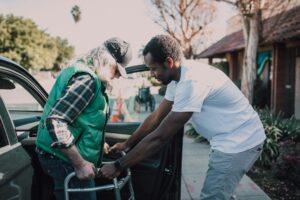John Candelario looked over his shoulder at the madness of the Las Vegas Convention Center as he walked down Convention Center Blvd. en route to an early, quiet dinner. “It really amazes me how huge it’s gotten,” said Candelario, a long-time IT and programming consultant from Southern California attending his 35th International CES. “This used to be an event where you saw some new technology, talked about how big this industry could get, and enjoyed seeing your old friends every year. Now…”
 Candelario didn’t need to finish. At International CES 2015, ellipses spoke about 180,000 words — one for each attendee who rolled into the City that Never Sleeps. They came for a week of keynotes, conferences, seminars, pitches, exhibits, dignitary and athlete appearances, products and technologies that doubtless left many with visions of products and gridlocked aisles for weeks afterward.
Candelario didn’t need to finish. At International CES 2015, ellipses spoke about 180,000 words — one for each attendee who rolled into the City that Never Sleeps. They came for a week of keynotes, conferences, seminars, pitches, exhibits, dignitary and athlete appearances, products and technologies that doubtless left many with visions of products and gridlocked aisles for weeks afterward.
Innovation & Tech Today showed up in full force as an International CES media partner, fanning across all three Las Vegas Convention Center halls, an outdoor pavilion, the Sands Convention Center, and five hotels — the Westgate, Aria, Venetian, Palazzo, and Cosmopolitan. In all, the show gobbled up 3 million square feet, which might have been how many steps our team walked.
What were the highlights? Which killer and disruptive technologies highlighted the show? We pondered these and other questions every day.
Eureka!
CES was new to most of the 200 exhibitors at Eureka Park. One of those exhibitors was Gripix, which rolled out state-of-the-art handles and multiple-angle mounting devices for adventurers, water sports participants, and outdoor enthusiasts who swear by their GoPros. Owner-creators Tyler Reid and Anthony Walsh, both long-time surfers (Reid’s grandfather, Butch Van Artsdalen, is a surfing legend), were overwhelmed at times. Reid deadpanned, “I guess we picked the right show to launch at.”
GoPro was so impressed that Nick Woodman and Co. floated the possibility of an acquisition offer. They weren’t alone: on the show’s final day, we counted no less than a half-dozen M&A “feeler” meetings taking place outside booths with fledgling Eureka Park company owners.
One of the most impressive sections was the Indiegogo cluster of mini-booths. The world’s second best-known organization in the $5.5 billion annual crowd funding arena (Kickstarter being No. 1), Indiegogo’s dozen beneficiaries on hand touted products ranging from computer accessories to eye-tracking drones and multi-purpose travel apps. “All of these companies got off the ground almost entirely from crowdfunding,” Global Marketing and Communications Director Jenn Clark said. “They are among our best success stories. All of them have the potential to sell widely on a national or global basis.”
Another impressive newcomer, Muzik, bypassed the madness on the floor and secured a penthouse suite at the Palazzo. Foot traffic and noise were replaced by a breakfast spread, coffee, and quiet conversation. At this show, which in some places looked like a mini version of NAMM, the music industry convention, Muzik’s products stood out.
Besides offering what they described as “the world’s first smart headphones”, which won a CES Innovation & Design Award, owner Jason Hardi unveiled Muzik’s newest creation: a virtual drum kit. A program opens on the iPad, from which you create a “drum kit” for the type of music you want to play. Then, it’s all hand-eye coordination and wi-fi connectivity as you move the sticks and arms in the air. It’s not exactly the set-up of Rush drummer Neal Peart, which takes a small truck to transport, but it’s amazing technology.
“I was like a lot of kids who wanted to play drums — I couldn’t,” said Hardi. “My parents couldn’t stand the noise. With this, you can set it to whatever volume you choose, play in the air, and tap your foot to create the bass drum effect.”
As for the headphones? They offer social networking and mobile apps, playlist synching to Rdio, Pandora and more, an accelerometer, proximity sensors and sterling sound with total noise isolation.
Likewise, Remote Reality was one of the more exciting, interactive technologies at CES. Remote reality uses parabolic mirrors to capture 360 degrees of video, which can be instantly streamed. When integrated with VR tech, the result is pretty cool. We put on the VR glasses while watching videos of skydiving and race cart driving. We looked as silly as the other VR users, viewing skydivers that weren’t really on the crowded Sands floor. “We’ve worked with Deadmou5, shot the 49ers, and more; so sports and entertainment [are our focus],” said president Randy Eckhardt. Regarding their work with Deadmou5, Randy explained a possible application of their tech: Fans could watch from home while connecting with others and accessing info on Deadmou5 via a website and app. Watch for them in the future – they’ll be working with Red Bull.
Eye-Tracking Drones & Other Peeks into the Future
International CES is about venturing into the future. Two companies, Panasonic and Intel, gave us multiple sneak peeks in keynote speeches that drew thousands. Enough advances were described to keep a speculative fiction author flush with story objects and research — without ever leaving Las Vegas. As Intel CEO Brian Krzanich put it, “The last time we saw change this big was 20 years ago, in the great year of 1995.” That was when, among other things, the Internet and e-mail became commonplace, and Microsoft unveiled a personal computing disrupter called Windows.
Krzanich’s presentation was spectacular. It featured HP’s state-of-the-art large business 3D printer, the six-millimeter thick Real Sense 3D Camera (a Best of CES Innovation award winner), a collaboration with the Marriott hotel chain for wireless charging stations, and immersive computing from the comfort of our laptops and tablets.
Nonetheless, drones stole the event. Krzanich demonstrated intuitive eye tracker drones that negotiated a 30-wall obstacle course flawlessly. While people were still buzzing from that, out came the Nixie, which won Intel’s $500,000 Best Wearables contest over 2,000 entrants. The Nixie is, well, amazing. It is a wristwatch-sized camera, worn like a watch. When you unstrap the camera, it turns into an eye-tracking drone. Throw it like a Frisbee, and it flies about ten feet away, shoots a selfie, and flies back.
“The 2D and 3D worlds are colliding,” Dion Weisler, CEO of the new HP, Inc. (which split from Hewlett-Packard in October 2014) said. “We all have to bring out the vision of a seamless physical and digital life. When these two worlds come together, that’s when magic happens.” Nixie’s 2D/3D collision was truly Big Bang.
Meanwhile, Panasonic’s “A Better Life, A Better World” conference emphasized the diversity and increased customer focus larger organizations now espouse. Consumer Electronics division president Julie Bauer (see page 28) discussed initiatives in digital imaging, personal care and beauty, 4K camcorders with a rotatable sub-camera, connected home packages, 4K UHD Blu-Ray machines, and numerous automotive technologies. That was coupled with futuristic announcements, such as the 300 million lithium-iron batteries they furnished to Tesla’s for use in its zero net energy, Gigafactory; and the town of Fujisawa, a 100% sustainable Japanese community of 4,000 built and connected by Panasonic and its partners. In addition, Panasonic is partnering with Spartan obstacle races, the New York City Triathlon, and 30 Lifetime Fitness events.
Smart Glasses, 3D Printing & Social Media: Tracking’s Newest Forms
For those of a certain age, say, over 20, remember when tracking pertained to following footsteps of people or animals in the wild?
Welcome to Tracking 2.0.1.5. Epson’s booth in the wearables section had a LOT going on. First, we saw the Epson Moverio BT 200 Smart Glass platform. We’re not huge fans of the smart glasses movement, so we were a bit skeptical. However, some of these applications are amazing, such as Ngrain’s application for service professionals. Barry Po, Director of Products, said a service technician “can look at a part, pull up information, and even instructions. We can show step by step how to repair that part.” In a pinch, less trained technicians could get an airplane or other piece of equipment up and running. The potential is incredibly cool.
In addition to industrial use, the Moverio Glasses also have gaming applications. Mark Ladd, CEO of Lyteshot, explained the possibilities. You can play Assassin with real people, using the Moverios to track your opponent, get information on them, and more.
While that seems dorky (hardly a bad word at CES), we were especially interested in the use of 3D printing. Lyteshot provides the sensor/controller, but you can 3D print a ‘gun’ to put in the controller during play. You can download a template or create (and even sell) your own. Darek Connole of Epson said, “We’re seeing things created we never even thought possible.”
It seems the last thing we need is more social media, but a couple of social video chatting platforms caught our eye. One, ooVoo, took us a little bit to understand the appeal, but the booth pulled us in immediately. Attendees stood in front of a giant wall comprised of two-sided tiles, one black and the other white. The wall created images and gave instructions based on the feedback received from cameras. For example, the wall may tell you to smile. When you smiled into the camera, the wall would create a happy face. ooVoo recognizes your emotions and animates your video chat accordingly.
While that’s pretty cool, the more impressive applications related to healthcare and business applications. For example, Autistic people have trouble identifying facial expressions or emotions of the people with whom they interact. ooVoo can let people on the autism spectrum know how their conversation partners are feeling. Eventually, the software may be able to detect if someone is lying.
New Horizons in Medical and Fitness Tech
“Seymour” was the buzzword at the Honeywell booth. A software platform designed with a clinician in mind, Seymour aims to limit the amount of re-admissions to hospitals. It would even eliminate the need for some in-home monitoring. Honeywell President John Bojanowski said that while biofeedback devices collect copious amounts of data, “the clinicians are saying: we don’t want it.” Seymour is designed for the clinician, who only needs access to some data. All the data may be nice to have, but as Bojanowski says, “when it comes down to it, are we actually driving better health?”
A CES Innovation Award winner, Sensoria, displayed one of the most unique wearables in the Sands Expo Halls. Sock sensors are able to provide real time feedback for runners. How do the socks know the correct way to run? Simple: the runner specifies she doesn’t want to put so much pressure on her heels when running, or wants to stick to a certain pace. When she veers away from these pre-set specifications, she’ll get a verbal notification through her phone via Bluetooth. In addition to the socks, Sensoria has shirts and sports bras that measure heart rate.
Epson may not be a company that immediately comes to mind when you think of fitness wearables (just as Honeywell might have triggered visions of defense contracts).
However, Epson is well positioned to change that perception. The parent company, Seiko Epson, produces medical equipment, which allows Epson to custom make wearables to measure the variables it wants, the magic variable being ‘intensity.’ Other wearables don’t measure intensity, and therefore can’t tell you when your workout may be causing more harm than good. Their Pulsense products also measure cadence, heart rate, and the other factors you’d expect in a wearable.
Fashion Statements
Fashion and tech is becoming a hot topic, and International CES 2015 reflected this trend. After a few products were floated in 2014, several booths now displayed phone cases with sports teams, rhinestones, and other personalized touches.
The FashionWare runway show at the WebMD lounge featured designers merging tech with fashion, and was one of our favorite spots. Project Runway fans recognized the show’s season two host, Nick Verros. The show attracted a good amount of spectators seemingly trying to figure out what was going on, while models walked the runway to show off the integrated tech. Some wore fitness clothes, while others sported clothing with built-in LED lights that displayed moving designs or words. From our perspective, the standout design was a Tornado Dress from Rainbow Winters.
To Capture the Action…
The Nikon booth was a dream come true for Melissa, a diehard fan of the brand. While en route to another interview, we were sucked in by the tiny Nikon world in the middle of the Las Vegas Convention Center. The company released a 300mm f/4 lens, which we tried with the Nikon D750: a camera getting a well-deserved amount of buzz. The combination was significantly lighter than the D610 and 24-70mm f/2.8 we carried around for the week. Not only did we get to watch a class presented by Joe McNally, but we also had our photo taken simultaneously by 48 cameras, creating a 360-degree photo experience. Additionally, there was a VR demonstration in which the VR world was ‘built’ by images made with the D810. The booth was one of our favorites of the show.
As a lover of off-camera flash, we really hate the flashes on smartphones. They’re either too bright, not bright enough, or constantly giving subjects red eye. Off-camera lighting solves the red eye, and being able to move the light provides complete control of the intensity. However, lights can be bulky and heavy to carry around, and it’s not worth the trouble for smartphone snaps.
For years, we’ve thought it would great to have a small video light that could easily and significantly improve smartphone photos. Well, knog has done it with [expose]. Designed to work with iPhones, the flash can connect via Bluetooth and sync with your camera. We used the [expose] in manual mode, and it works perfectly. The light has three settings of brightness, and it charges quickly via a USB charger. You can keep it on your keychain, keeping it close for use. Knog will be releasing an Android compatible light this year.
Party, Party!
CES featured no less than 50 parties, some public, most by invitation-only. There were even some fun pop-up events. Hosts included Snail Games, AT&T, MediaLink, Pepcom Digital, Hulu, Western Digital, Bluetooth, MakerBot, IDG and Newegg. Our team of eight fanned out several times to make appearances, and we were not disappointed.
One of the most notable events was the 66th Technology & Engineering Emmy Awards at the Bellagio, which honored behind-the-scenes wizardry. Jeopardy’s Alex Trebek hosted the semi-formal event, a $700-per-plate affair for the uninvited, while Sony President Kazuo Hirai received the Lifetime Achievement Award.
Another attention grabber was the JVC Party. JVC has carved great inroads to re-establish itself in the home stereo and entertainment space, featuring a brand name millions knew well during the turntable heyday of rock music. JVC had plenty to celebrate, so the company brought along former All-Pro Philadelphia Eagles (and University of Nevada-Las Vegas) quarterback Randall Cunningham, and 2009 British Open golf champion Stewart Cink. What happened next was, well, life at a party by the life of the party. Our resident ninja warrior, Kelsey Elgie Domier, locked horns with Cink in a putting contest. They tied.
There was much more to the event. The food and drinks were delicious, and JVC’s TV’s played majestic, captivating footage of landscapes on loop. We sat on the patio with a private pool; the scene was surreal. At one point, a guest decided to hit a golf ball off the patio. We thought he was joking. He directed us to stand back, and swung. The ball failed to clear the railing, and hit one of us in the leg. He definitely wasn’t Stewart Cink.
That same night, we made an appearance at the Monster retailer awards party, held in Planet Hollywood’s Axis Theater (Brittney Spears had the night off). After the ceremony, the crowd multiplied to about 2,500, for a reason. Onstage strode Monster owner Noel Lee’s longtime San Francisco friend, Steve Miller, who played a rock solid 90-minute concert that reminded many why the Space Cowboy (or The Joker, take your pick) sold 40 million records during his great hit-making run.
Our full team re-convened at the Snail Games party, held in the hip Sayer’s club to celebrate a disrupter at a show where almost everyone claimed to disrupt something (a reminder of Disruption by Design author Paul Paetz’s cautionary comment to us: “For every several hundred companies, one is a true disrupter.”). Snail Games has released a smart phone that delivers video games at full resolution and full speeds. They announced it in I&T Today’s winter issue, and then showcased it at CES. It is a true disrupter.
We enjoyed an evening in which the open bar, incredible desserts, DJs and dancers were a big highlight for a young crowd (does that make us old?). One, a spot-on Beyonce-Tyra Banks lookalike (her natural appearance, by the way), owned the dance floor whenever she strode onto it. Those who dance better to technology played Snail video games on large flatscreens.
When we flew out of Las Vegas, bleary-eyed and brain fried, we felt like we’d seen enough technology for a year, yet we’d only scratched the surface. That’s the CES experience.










